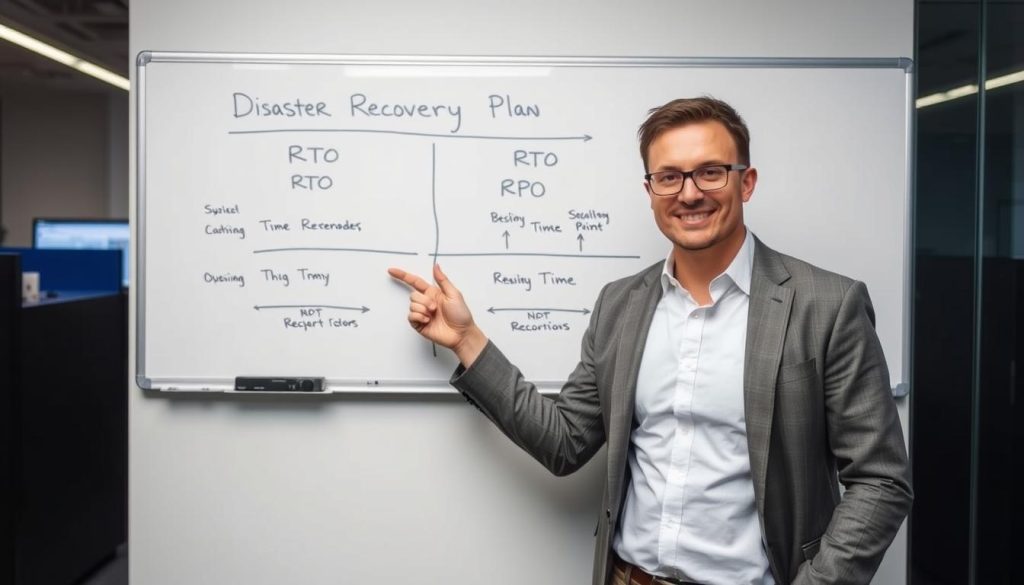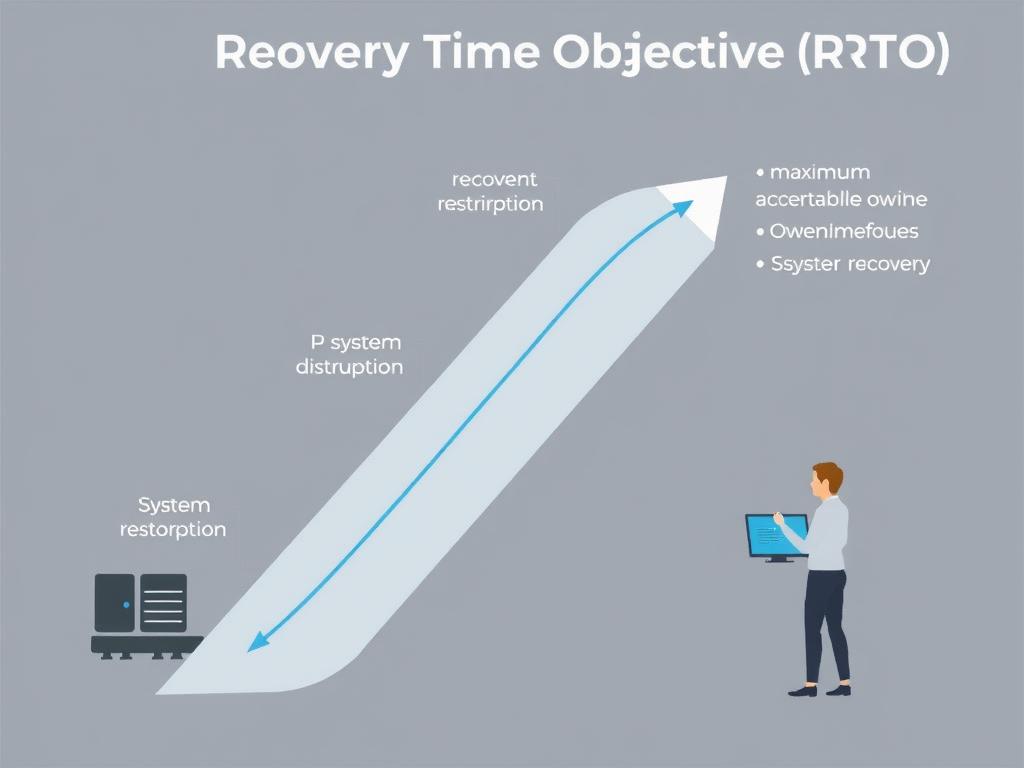
Core Concepts: RTO and RPO Explained
Before diving into implementation details, let’s establish a clear understanding of what RTO and RPO actually mean and how they differ from each other.
What is RPO (Recovery Point Objective)?
Recovery Point Objective (RPO) refers to the maximum acceptable amount of data loss measured in time. It answers the question: “How much data can your organization afford to lose?” For example, an RPO of 4 hours means your systems and data will be recovered to a state that existed no more than 4 hours before the disruption occurred.
Think of RPO like taking snapshots of your cash register throughout the day. If you take snapshots every hour and a power outage occurs, you’ll lose at most one hour of transaction data—that’s your RPO. Organizations with stringent data integrity requirements, such as financial institutions, typically aim for very short RPOs (minutes or even seconds).
What is RTO (Recovery Time Objective)?
Recovery Time Objective (RTO) is the maximum acceptable time it takes to restore systems, applications, and business functions after a disruption. It answers the question: “How long can your operations be down?” An RTO of 2 hours means your critical systems must be back online within 2 hours of an incident.
Using our earlier analogy, if your physical store experiences a power outage, RTO represents how long customers will wait outside before they leave for a competitor. The shorter your RTO, the faster you need to restore operations, which typically requires more sophisticated (and expensive) recovery solutions.

The Critical Difference Between RPO and RTO
While both metrics are measured in time units, they focus on different aspects of recovery:
- RPO is backward-looking, measuring how far back in time you’ll need to go to recover data
- RTO is forward-looking, measuring how long it will take to restore operations from the point of failure
- RPO focuses on data loss tolerance, while RTO focuses on downtime tolerance
- RPO influences backup frequency and strategy, while RTO influences recovery infrastructure and processes
How to Calculate RTO and RPO: Practical Methods
Step-by-Step RTO and RPO Calculation Process
- Conduct a Business Impact Analysis (BIA) to identify critical business processes
- Quantify the financial, operational, and reputational impact of downtime and data loss
- Map all system and application dependencies
- Determine acceptable downtime thresholds for each system
- Assess data change rates and acceptable data loss periods
- Calculate costs associated with meeting various RTO/RPO targets
- Balance business requirements against implementation costs
- Document and validate final RTO/RPO values with stakeholders

Practical Calculation Examples
Example 1: Transactional Payment System
Business Context: An e-commerce company processes approximately $10,000 in transactions per hour. Each minute of data loss could result in lost orders and customer dissatisfaction.
Impact Analysis:
- Revenue impact: $10,000 per hour
- Customer impact: High (immediate order loss)
- Reputation impact: High (payment processing is critical)
Calculation:
- Maximum acceptable financial loss: $2,500
- RTO calculation: $2,500 ÷ $10,000/hour = 0.25 hours = 15 minutes
- RPO calculation: Based on transaction volume and criticality = 1 minute
Technical Implication: Requires synchronous replication and automated failover systems.
Example 2: Internal File Share System
Business Context: A company’s internal document repository is used by 50 employees with an average hourly productivity value of $50 per employee.
Impact Analysis:
- Productivity impact: $2,500 per hour (50 employees × $50)
- Customer impact: Low (internal only)
- Reputation impact: Low
Calculation:
- Maximum acceptable productivity loss: $60,000
- RTO calculation: $60,000 ÷ $2,500/hour = 24 hours
- RPO calculation: Based on file update frequency = 4 hours
Technical Implication: Can use standard backup systems with daily full backups and 4-hour incremental backups.
Example 3: Simple Financial Formula
Basic RTO Calculation Formula:
RTO = Maximum Acceptable Financial Loss ÷ Hourly Cost of Downtime
Example:
Annual revenue: $5,000,000
Business hours per year: 2,080
Hourly revenue: $2,404
Maximum acceptable loss per incident: $5,000
RTO = $5,000 ÷ $2,404/hour = 2.08 hours

RTO and RPO Implementation Strategies
Once you’ve calculated your RTO and RPO requirements, the next step is implementing technical solutions that can meet these objectives. Different environments require different approaches.
On-Premises Infrastructure Strategies
For Tight RPO (Minutes or Seconds)
- Synchronous storage replication between primary and secondary sites
- Storage-based snapshots at frequent intervals
- Database transaction log shipping
- Continuous Data Protection (CDP) solutions
For Fast RTO (Minutes)
- Hot standby systems with automated failover
- Clustered application environments
- Load-balanced services across multiple sites
- Pre-staged recovery environments

Cloud-Native Implementation Approaches
For Tight RPO (Minutes or Seconds)
- Multi-region database replication
- Cloud-native backup services with point-in-time recovery
- Continuous replication between availability zones
- Event-driven backup triggers on data changes
For Fast RTO (Minutes)
- Auto-scaling groups across multiple regions
- Infrastructure as Code (IaC) for rapid environment rebuilding
- Multi-region load balancing
- Containerized applications with orchestration
Hybrid Environment Considerations
Many organizations operate in hybrid environments, combining on-premises and cloud resources. This creates unique challenges for meeting RTO and RPO objectives:
- Ensure consistent backup and recovery processes across environments
- Implement cross-environment monitoring tools like AWS CloudWatch or Azure Monitor
- Consider data sovereignty and compliance requirements when moving data between environments
- Test recovery processes that span both on-premises and cloud components
Ready to Implement Your Recovery Strategy?
Download our comprehensive Disaster Recovery Planning Toolkit with templates, checklists, and implementation guides based on NIST SP 800-34 recommendations.
RTO and RPO Best Practices
Implementing effective RTO and RPO strategies requires more than just technical solutions. Here are key best practices to ensure your recovery objectives are realistic, achievable, and aligned with business needs.

Testing and Validation
Recovery objectives are meaningless without regular testing to validate that they can actually be met:
- Conduct quarterly tabletop exercises to walk through recovery procedures
- Perform bi-annual component-level recovery tests (database restores, server rebuilds)
- Schedule annual full-scale disaster recovery simulations
- Document actual recovery times and data loss to compare against objectives
- Update recovery procedures based on test results and lessons learned
Tiering Applications by Criticality
Not all systems require the same level of protection. Implement a tiered approach to balance cost and protection:
| Tier | Criticality | Typical RTO | Typical RPO | Example Systems |
| Tier 1 | Mission-Critical | Payment processing, core transaction systems | ||
| Tier 2 | Business-Critical | CRM, ERP, email systems | ||
| Tier 3 | Important | Internal collaboration tools, reporting systems | ||
| Tier 4 | Non-Critical | Archives, development environments |
Documentation and Governance
Proper documentation and governance ensure that recovery objectives are understood, maintained, and achievable:
- Document RTO and RPO values for each system in a central repository
- Create detailed recovery runbooks with step-by-step procedures
- Assign clear ownership for each recovery process
- Establish a change management process for updating recovery objectives
- Review and update documentation quarterly

Real-World RTO and RPO Case Studies
Learning from real-world examples can provide valuable insights into effective recovery strategies. Here are two contrasting case studies that illustrate different approaches to RTO and RPO implementation.
Case Study 1: E-Commerce Company
Company Profile: Mid-sized online retailer with $5M annual revenue
Challenge: Needed to protect payment processing while managing limited IT budget
Approach:
- Implemented tiered recovery strategy
- Set payment systems at Tier 1 (RTO: 30 min, RPO: 5 min)
- Set marketing site at Tier 2 (RTO: 6 hours, RPO: 12 hours)
- Used cloud-managed database replicas for payments
- Implemented nightly backups for less critical systems
Results:
- Survived major cloud region outage with only 22 minutes of payment processing downtime
- Lost only 3 minutes of transaction data
- Marketing site recovered within 4 hours
- Achieved protection goals while staying within budget
Key Lesson: Prioritizing critical systems and accepting longer recovery times for non-revenue systems can create an effective, balanced strategy.

Case Study 2: Global Financial Services Firm
Company Profile: Large financial institution with strict regulatory requirements
Challenge: Needed near-zero downtime and data loss for core banking systems
Approach:
- Implemented active-active multi-region architecture
- Used synchronous database replication
- Deployed automated health monitoring with failover
- Conducted monthly recovery testing
- Maintained dedicated disaster recovery team
Results:
- Achieved RTO of
- Maintained RPO of
- Successfully passed regulatory audits
- Higher infrastructure costs offset by meeting SLA requirements
Key Lesson: For organizations with stringent recovery requirements, investing in redundant infrastructure and automation is essential but requires significant resources.
Lessons Learned from Recovery Failures
Even well-planned recovery strategies can fail. Here are important lessons from real-world recovery failures:
- Hidden Dependencies: Overlooked dependencies on DNS, authentication systems, and third-party services caused unexpected delays in recovery
- Insufficient Testing: Organizations that tested only components, not end-to-end recovery, discovered integration issues during actual disasters
- Outdated Documentation: Recovery procedures that weren’t updated after system changes led to failed recovery attempts
- Vendor SLA Misalignment: Recovery objectives that weren’t aligned with vendor SLAs created recovery gaps

Learn from Industry Experts
Download our collection of detailed case studies and expert interviews on successful disaster recovery implementations across various industries.
Conclusion: Making RTO and RPO Work for Your Organization
Understanding and implementing effective RTO and RPO strategies is essential for business resilience in today’s digital environment. By following the principles and practices outlined in this guide, you can develop a disaster recovery approach that balances business requirements with technical and financial constraints.
Key Takeaways
- RTO defines how quickly you need to recover, while RPO defines how much data loss you can tolerate
- Calculate these metrics based on business impact analysis and financial considerations
- Implement tiered protection strategies based on system criticality
- Test regularly to validate that recovery objectives can be met
- Document procedures and assign clear ownership for recovery processes
- Review and update your strategy as business needs and technologies evolve

Next Steps for Implementation
Ready to strengthen your organization’s disaster recovery capabilities? Here are practical next steps to get started:
- Conduct a Business Impact Analysis for your critical systems
- Calculate preliminary RTO and RPO values based on business requirements
- Assess your current recovery capabilities against these objectives
- Identify gaps and develop an implementation roadmap
- Schedule your first recovery test within 90 days
Remember that disaster recovery planning is not a one-time project but an ongoing process. Regular testing, continuous improvement, and adaptation to changing business needs are essential for maintaining effective recovery capabilities.
